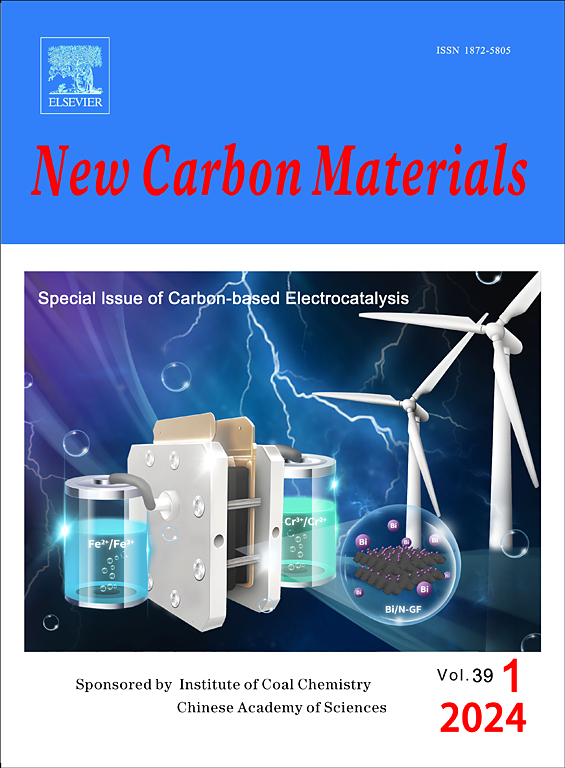N/O共掺杂微孔碳作为超级电容器的高性能电极
IF 5.7
3区 材料科学
Q2 Materials Science
引用次数: 0
摘要
孔隙率可调、杂原子掺杂可控、成本低的碳材料作为超级电容器电极受到广泛关注。然而,使用具有丰富微孔、高表面积和高掺杂含量的碳材料制造具有高能量输出的水性超级电容器仍然是一个挑战。我们报道了通过对苯甲醛和2,6-二氨基吡啶的聚合反应,简单地合成了相互连接的碳球。该合成通过调节共聚物和KOH活化剂的质量比来提高电荷存储能力和高能量输出,这是由于多孔结构中大量的微孔、高N/O含量和快速的离子扩散通道提供了高离子可达面积。在PMEC∶KOH质量比为1∶1时,典型碳电极的导电框架的高电解质离子吸附面积(2599.76 m2 g−1)和N/O掺杂原子产生了优越的比容量(303.2 F g−1@0.5 a g−1),使组装的对称电容器具有11.3 Wh kg−1@250 W kg−1的高能量输送。本研究提出了一种简单的合成微孔碳的策略,并强调了其在koh基超级电容器中的潜在应用。下载:下载高分辨率图片(53KB)下载:下载全尺寸图片本文章由计算机程序翻译,如有差异,请以英文原文为准。
N/O co-doped microporous carbon as a high-performance electrode for supercapacitors
Carbon materials with adjustable porosity, controllable heteroatom doping and low-cost have been received considerable attention as supercapacitor electrodes. However, using carbon materials with abundant micropores, a high surface area and a high-dopant content for an aqueous supercapacitor with a high energy output still remains a challenge. We report the easy synthesis of interconnected carbon spheres by a polymerization reaction between p-benzaldehyde and 2,6-diaminopyridine. The synthesis involves adjusting the mass ratio of the copolymer and KOH activator to achieve increased charge storage ability and high energy output, which are attributed to the high ion-accessible area provided by the large number of micropores, high N/O contents and rapid ion diffusion channels in the porous structure. At a PMEC∶KOH mass ratio of 1∶1, the high electrolyte ion-adsorption area (2599.76 m2 g−1) and the N/O dopant atoms of the conductive framework of a typical carbon electrode produce a superior specific capacity (303.2 F g−1@0.5 A g−1) giving an assembled symmetric capacitor a high energy delivery of 11.3 Wh kg−1@250 W kg−1. This study presents a simple strategy for synthesizing microporous carbon and highlights its potential use in KOH-based supercapacitors.
- Download: Download high-res image (53KB)
- Download: Download full-size image
求助全文
通过发布文献求助,成功后即可免费获取论文全文。
去求助
来源期刊

New Carbon Materials
MATERIALS SCIENCE, MULTIDISCIPLINARY-
CiteScore
6.10
自引率
8.80%
发文量
3245
审稿时长
5.5 months
期刊介绍:
New Carbon Materials is a scholarly journal that publishes original research papers focusing on the physics, chemistry, and technology of organic substances that serve as precursors for creating carbonaceous solids with aromatic or tetrahedral bonding. The scope of materials covered by the journal extends from diamond and graphite to a variety of forms including chars, semicokes, mesophase substances, carbons, carbon fibers, carbynes, fullerenes, and carbon nanotubes. The journal's objective is to showcase the latest research findings and advancements in the areas of formation, structure, properties, behaviors, and technological applications of carbon materials. Additionally, the journal includes papers on the secondary production of new carbon and composite materials, such as carbon-carbon composites, derived from the aforementioned carbons. Research papers on organic substances will be considered for publication only if they have a direct relevance to the resulting carbon materials.
 求助内容:
求助内容: 应助结果提醒方式:
应助结果提醒方式:


